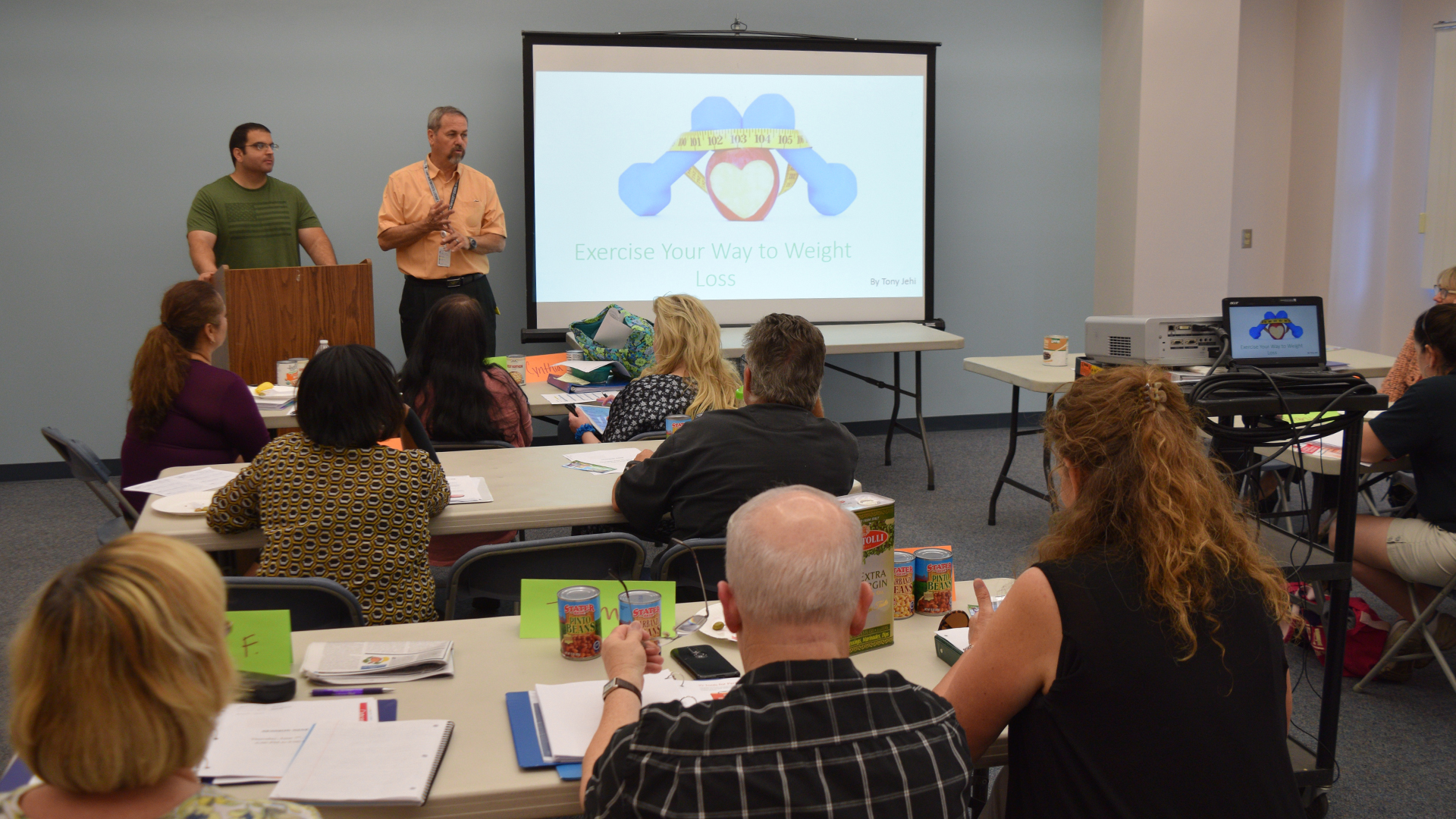
By Larry Kidder | Hildemar Dos Santos, PhD (standing, right), director of the Office of Preventive Care, shares information to 16 of the 20 participants enrolled in the Full Plate Diet Study. To his left is DrPH student Tony Jehi, who has taught the majority of the 10 class sessions to study participants.
Advertisements for yo-yo diets fill the airways, print, and billboards with promises of guaranteed weight loss in record time. In some cases, people actually experience success for a limited time; rarely is it permanent.
Far more typical is the direct relationship between how fast one loses weight and how fast it comes back; hence, the yo-yo analogy. These fad diets often lead one’s body to switch into starvation mode, slowing metabolism and ironically storing reserves in the form of fat—the exact opposite of the desired result.
Alternative diets are no substitute for practicing the principles of healthy eating. A nutritious diet follows basic principles that take people back to simpler times when good nutrients were not processed out of foods.
The Full Plate Diet, created by the Ardmore Institute of Health—headquartered in Oklahoma, works on the premise that healthy eating will naturally lead to weight loss, as well as increased energy. Drayson Center’s Office of Preventive Care has been conducting a study with 20 participants that began April 12 and will continue with weekly educational sessions on Thursday evenings through the middle of June.
To the join the study, participants underwent health measurements, including blood work, body composition, and lifestyle surveys. In addition, their eating habits have been periodically documented both online and in writing. A second control group is being monitored during the corresponding time and will take the same coursework when the official study concludes.
Hildemar Dos Santos, PhD, director of the Office of Preventive Care, is serving as the principal investigator for the Full Plate Diet Study, assisted by nutrition students Mikaela Curtis and An Nguyen (working toward their MPH degrees in nutrition), Tony Jehi (enrolled in the DrPH nutrition program), and Muath Alghamdi (working toward an MPH in health education).
The Full Plate Diet works on the basis of a number of principles. First, replacing foods that have less dietary fiber with those containing higher amounts will result in a number of health benefits. Satiety—feeling full—will take place earlier and last longer as the food passes through the gastrointestinal system. Water-soluble fiber, found in many fresh vegetables, helps to reduce LDL cholesterol, leading to better heart health.
Non-soluble fiber serves to “sweep” the intestines, helping to prevent colon cancer and other problems. It also feeds good bacteria in the gut and reduces the urge to binge on sweet, fatty, or salty snack foods.
Second, beans are a major emphasis in the Full Plate Diet. Legumes, in general, are among the most complete foods available, with ample carbohydrates, proteins, and dietary fiber. By rinsing them straight out of the can or after soaking, their flatulent production can be significantly reduced.
Third, eating foods that are as unprocessed as possible leads to maximum health benefits from their natural nutrients. How the foods are prepared can also make a difference. For instance, frying vegetables destroys many of the vitamins and other nutritional benefits. While boiling them in water improves the nutrition, steaming vegetables is ideal.
Fourth, drinking adequate amounts of water—up to eight glasses per day—helps the body process food as well as eliminate waste and toxins with maximum efficiency. Fruit and vegetable juices are not nearly as helpful as the actual fruits and vegetables themselves because they are calorie-dense without making the body work for the nutrients. This can contribute to diabetes, obesity, and other chronic lifestyle diseases.
Fifth, adding some moderate daily exercise keeps the metabolic rate elevated, burning more calories. Even the simple practice of getting up from one’s desk and moving from time to time during the day can significantly impact health.
Last among the priorities, by design, is the topic of weight loss. Yes, weight will slowly disappear because of the body’s increased efficiency in processing food and turning it into energy, as well as the efficient removal of waste and toxins. Weight loss is not emphasized because it occurs naturally by improving one’s diet and adding exercise.
Enemies of weight loss and health are also addressed. In addition to the processing of food, large amounts of various sugars are added to many foods, making them calorie-dense. High-fructose corn syrup is the worst culprit; any food that lists it in the ingredients should be avoided. Trans-fats, now largely eliminated by many food manufacturers and restaurant chains in the U.S., are extremely difficult for the body to use—so it turns them directly into fat. Processed meats contain additives that have recently been discovered to contribute to cancer.
Participation in the Full Plate Diet Study has led to a number of personal benefits, including steady weight loss and increased energy. Most importantly, the dietary changes have been gradual and sustainable.
Meals are best when they start with a salad. Using a smaller plate gives the impression that more is being consumed. Slower eating with more conversation gives the stomach time to signal the brain that it is filling up. Eating a higher ratio of vegetables to entrées and desserts shifts the balance of the meal in favor of health without eliminating the joy of eating. Portion sizes naturally reduce because the appetite becomes more manageable.
Personal and group results of the current Full Plate Diet Study will be shared as they become available. Stay tuned for a follow-up article. For more information, visit the website fullplateliving.org. For health testing and counsel, visit Drayson Center’s Office of Preventive Care, located between the weight room and racquetball courts.
.jpg)
Dos Santos demonstrates some stretching and exercise techniques to help class participants add those components to their daily routines. Later, he showed them how to use some of the weight machines for strength training.
